Upwards movement was expected for Friday, but this did not happen.
However, the lower trend line on the hourly Elliott wave chart did work perfectly to show where downwards movement found support.
Summary: The trend line on the hourly chart needs to be breached before confidence can be had that this downwards movement is over. While price remains in that small channel downwards movement may yet continue. If the channel is breached, then expect a third wave up has begun to a target at 2,153.
To see a weekly chart and how to draw trend lines go here.
Changes to last analysis are italicised.
Bull Wave Count
The ending contracting diagonal may still be incomplete.
The diagonal is contracting. Minute wave iii is shorter than minute wave i, and minute wave iv is shorter than minute wave ii. Minute wave iv overlaps into minute wave i price territory as it must for a diagonal. Within an ending diagonal, all the sub waves must subdivide as zigzags.
At 2,185, minuettte wave (c) would reach 2.618 the length of minuette wave (a); this target allows for a reasonable overshoot of the upper i-iii diagonal trend line.
The diagonal trend lines would cross over on 3rd November. The diagonal must end a reasonable amount of time before that date, because diagonals end before their trend lines cross. Minute wave v would last a total Fibonacci 21 days on the 8th July.
Minuette wave (b) may not move beyond the start of minuette wave (a) below 2,072.14.
Minute wave v may not be longer than equality with minute wave iii at 2,225.95, and the third wave may not be the shortest.
Overall this wave count has a good look. It sees minute wave iii as complete at the more recent high, and within it minuette wave b is a combination: zigzag – X – triangle.
The trend line still has not been breached by a close of 3% or more of market value since its inception in November 2011, but it is no longer exactly where price is finding support, and the strength of that line appears to be waning.
I have a preference for this bull wave count because we should always assume the trend remains the same until proven otherwise. While there is no confirmation of a bear market I will assume the S&P remains in a bull market.
If upwards movement continues past the limit of minute wave v at 2,255.95, then I will again publish the very bullish alternate.
Subminuette wave ii was not over and moved lower. There is now no Fibonacci ratio between micro waves A and C; micro wave C is longer than 2.618 the length of micro wave A.
The structure within micro wave C may again be seen as complete, but price remains well contained within its channel. A breach of the narrow blue channel is required to indicate that micro wave C is over, and so subminuette wave ii is most likely over and subminuette wave iii may be expected to have begun.
Subminuette wave ii is almost at the 0.618 Fibonacci ratio of subminuette wave i.
If price does not move lower, then at 2,153 subminuette wave iii would reach equality in length with subminuette wave i. If price moves lower, then this target must also move correspondingly lower.
If subminuette wave ii does continue lower, then it would be extremely likely to end if price again touches the lower pink diagonal trend line. A small overshoot of that line would be acceptable, but a breach would not.
The green trend line on the TA chart has been reached, and price bounced up from there today. That may provide final support for this downwards movement.
I am again concerned today that the last small upwards wave at the end of the session does not subdivide as a five on the five minute chart and fits best as a three. This indicates that downwards movement may not yet be quite over.
Subminuette wave ii may not move beyond the start of subminuette wave i below 2,072.49.
Alternate Bull Wave Count
It is possible that the S&P has seen a primary degree (or for the bear count below a cycle degree) trend change.
This wave count absolutely requires confirmation at the daily chart level before any confidence may be had in a primary (or cycle) degree trend change. Confirmation would come with:
1. A new low below 2,072.14.
2. A clear five down on the hourly chart.
3. A close of 3% or more of market value below the lower aqua blue trend line. If the line is now breached at 2,118, then a close at 2,055 or below is required to confirm a bear market.
4. A clear five down on the daily chart.
5. A new low below 1,820.66.
As each condition is met the probability of a substantial trend change would increase.
Primary wave 4 would most likely be a time consuming flat, triangle or combination in order to exhibit structural alternation with the zigzag of primary wave 2. Primary wave 2 lasted 12 weeks. Primary wave 4 is likely to be longer in duration because combinations and triangles particularly are more time consuming than zigzags which tend to be quick corrections. Primary wave 4 may be expected to last more than 12 weeks, and may end with a total Fibonacci 13 or more likely 21 weeks.
For this more bearish wave count to be taken seriously it requires at least a clear five down on the hourly chart.
At this stage, a trend change is looking somewhat likely so I’ll list points in its favour. However, these points indicate a trend change to come and not exactly when it will happen and so they support both the main and this alternate bull wave count:
1. ADX is above 20, and the -DX line is above the +DX line indicating a new downwards trend.
2. The long held bull market trend line, the strongest piece of technical analysis on ALL charts, has again been recently breached. But the breach was small and did not close 3% or more of market value below the line, so a bear market is not indicated.
3. There is quadruple negative divergence between price and MACD on the weekly chart.
4. There is double negative divergence between price and MACD on the daily chart.
5. There is persistent and strong negative divergence between price and RSI on the monthly chart. The last time this happened was October 2007 and we all know what happened after that…
6. A long held bull trend line on On Balance Volume going back to October 2014 has been breached and is no longer providing support.
7. Nasdaq is making new all time highs. Only DJT now is required to make a new all time high to confirm continuation of a bull market. Failure of DJT to confirm the bull market does not mean a bear market exists and just indicates caution.
The only possibility for a first wave down now is a leading diagonal. This has a lower probability than an impulse, so the probability of a trend change at primary degree (or cycle degree for the bear count below) having occurred at the last all time high is low.
Leading diagonals require sub waves 2 and 4 to be zigzags, and sub waves 1, 3 and 5 are also most commonly zigzags but may sometimes be impulses.
Second and fourth waves within diagonals are normally deep, between 0.66 to 0.81 of the prior wave, but here minute wave ii is much deeper at 0.93 and the structure is now complete. The probability of this alternate is reduced.
Minute wave ii may not move beyond the start of minute wave i above 2,134.72.
Bear Wave Count
The subdivisions within primary waves A-B-C are seen in absolutely exactly the same way as primary waves 1-2-3 for the alternate bull wave count.
To see the difference at the monthly chart level between the bull and bear ideas look at the last historical analysis here.
At cycle degree, wave b is over the maximum common length of 138% the length of cycle wave a, at 170% the length of cycle wave a. At 2,393 cycle wave b would be twice the length of cycle wave a and at that point this bear wave count should be discarded.
Technical Analysis
ADX is now below 20 and declining, there is no clear trend, and the S&P 500 is range bound.
Downwards movement found support just below the green trend line. This may be enough to initiate a bounce up from here on Monday.
Friday’s candlestick is a red doji, indicating indecision and a balance of bulls and bears. It may be the end of this downwards movement.
The long divergence between price and On Balance Volume (lilac trend lines) is an indicator that a deeper and longer lasting downwards movement may be coming soon.
This analysis is published about 05:02 p.m. EST.

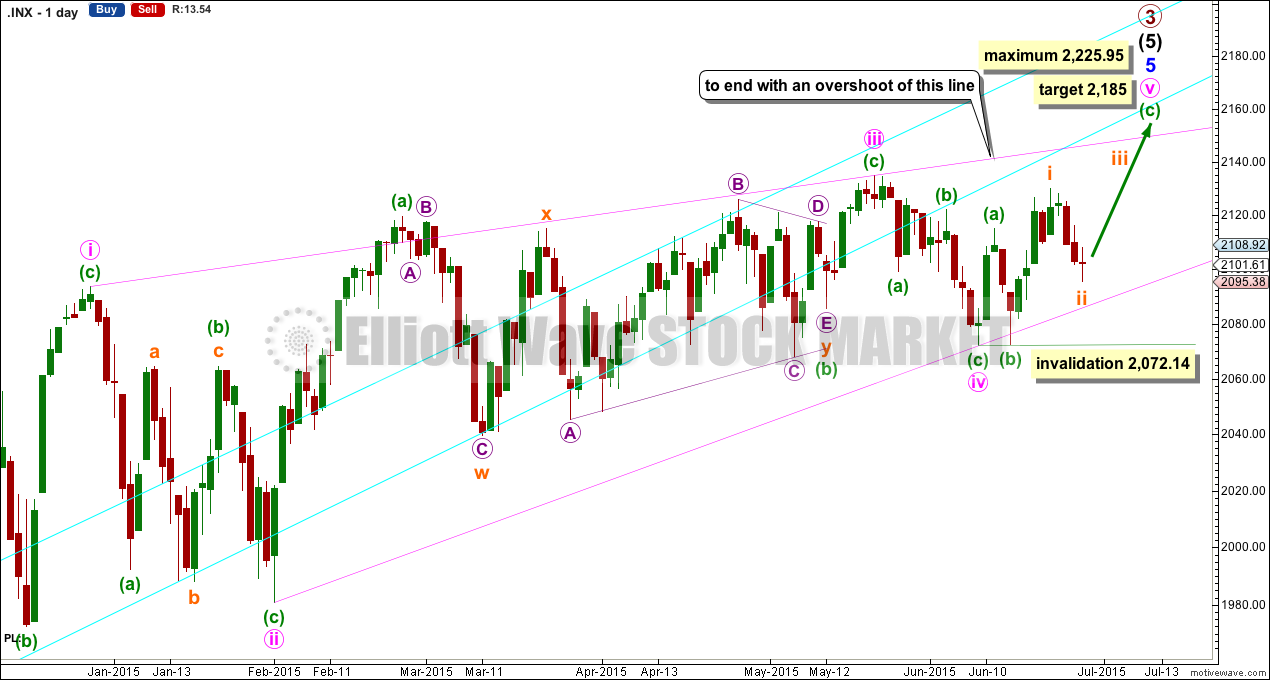
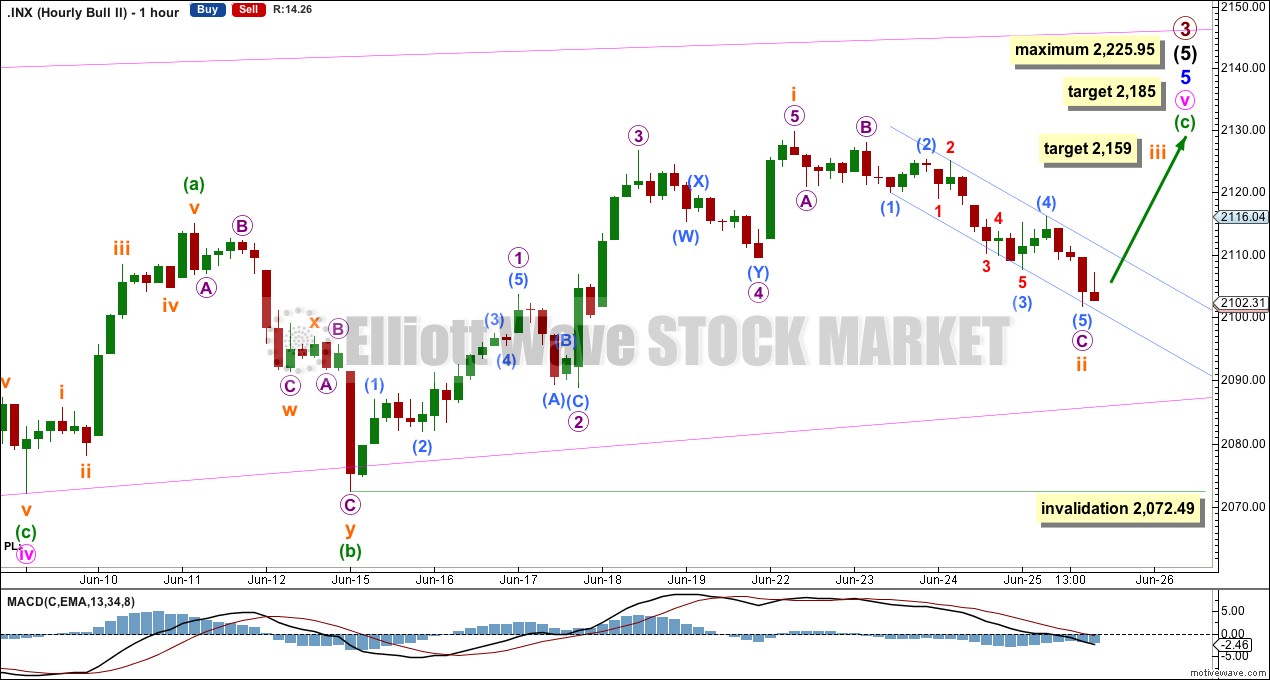
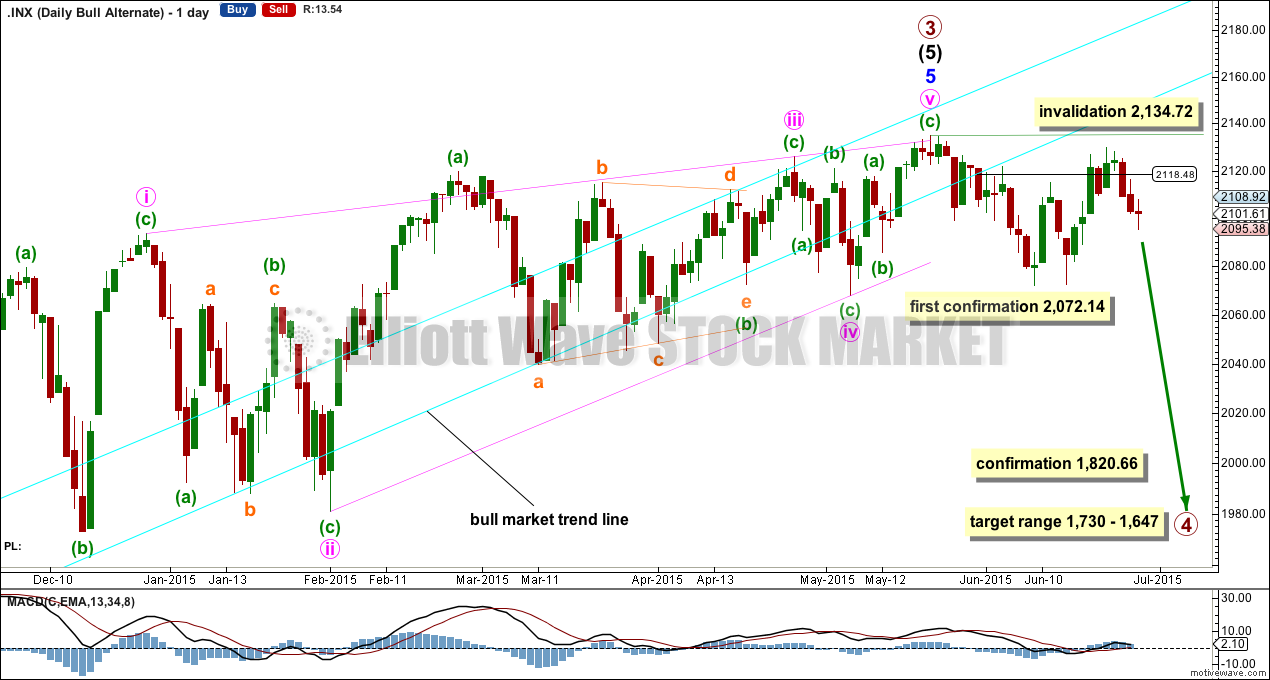

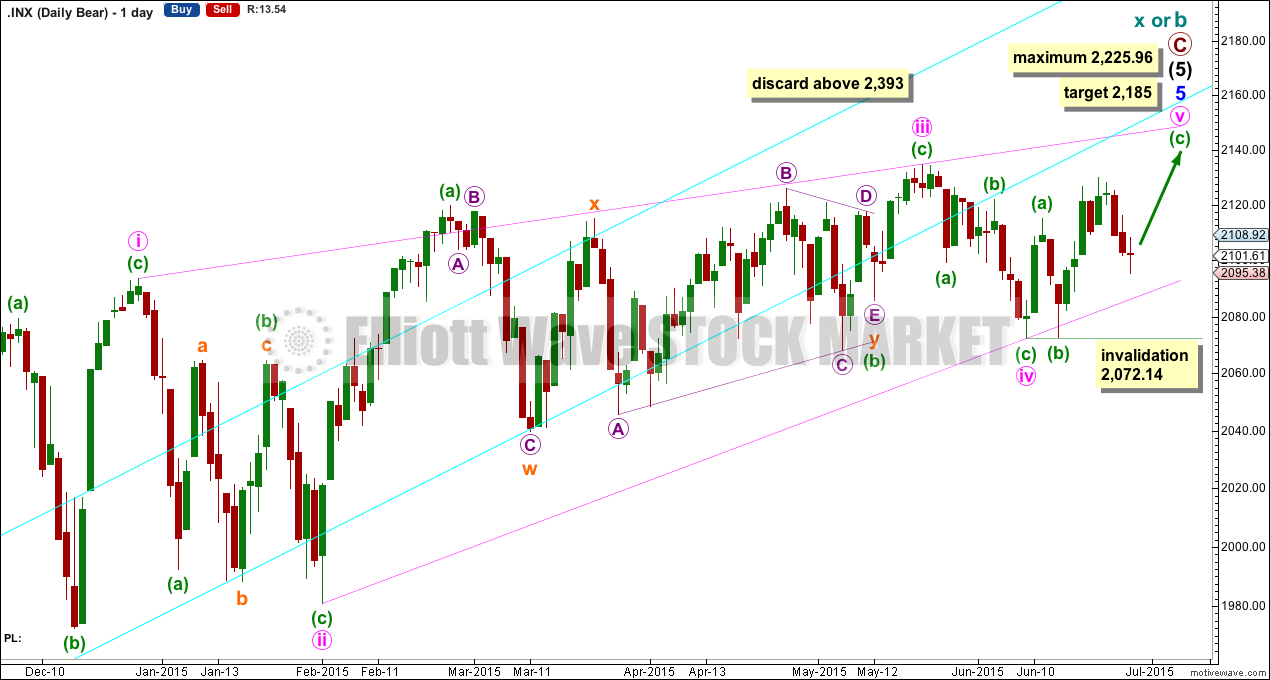
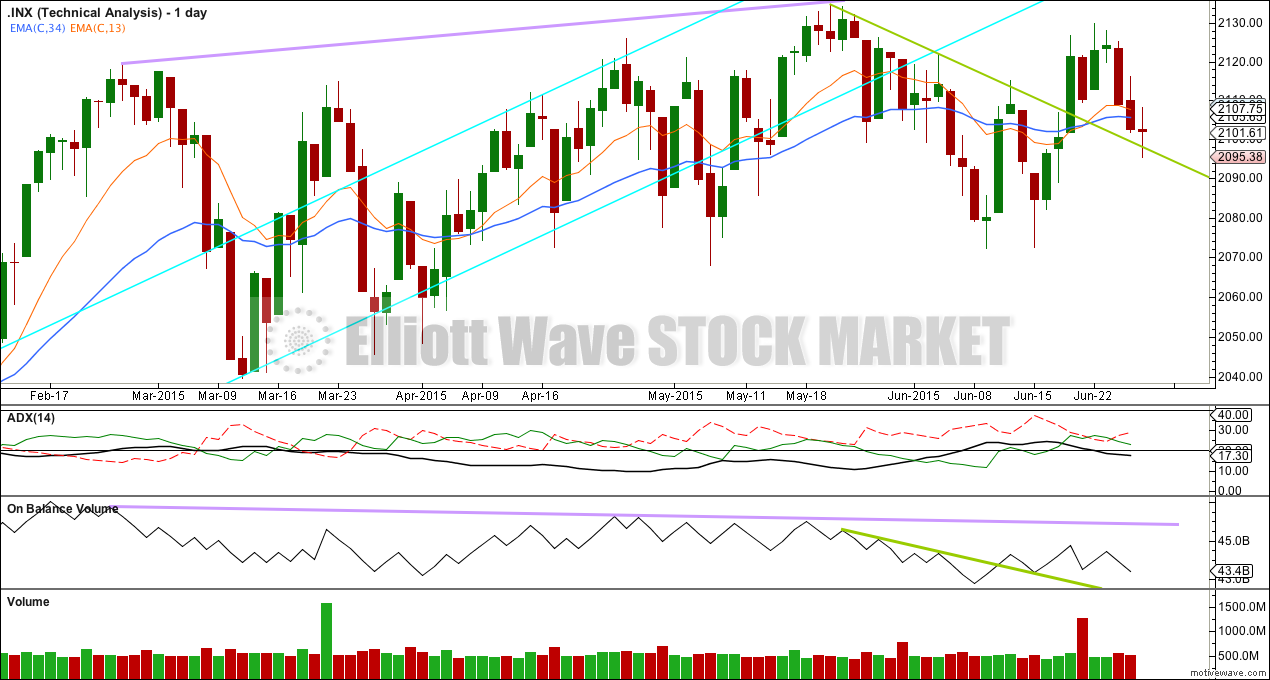
Hi Lara:
If we are indeed coming up on wave C down for a Grand Super Cycle II correction, any ideas on how long it will last? You pointed out that GSC waves should be generational in duration but A and B have so far lasted only about 15.5 years. Thanks!
I have noticed when I did the Grand SuperCycle analysis that the corrections are a lot quicker than the impulsive waves.
The Great Depression had the market falling in it’s big zigzag down for only 4 years I think. And that was a Super Cycle wave.
If the Grand Super Cycle wave count which sees the market now in a Grand Super Cycle wave II is correct, and Super Cycle wave C needs to unfold downwards it could be over within only three or four years.
And that would be okay.
Because those durations are guidelines, not rules. And Grand Super Cycle I did last generations.
Go back to the Grand Super Cycle analysis and look at the bear wave count there, you’ll notice that the corrections are much quicker than the impulsive waves.